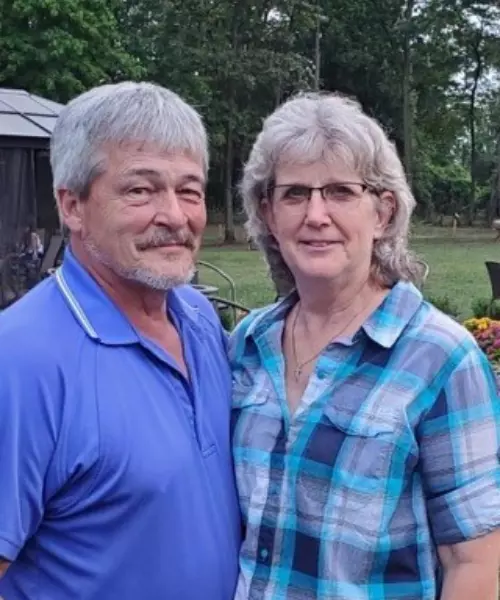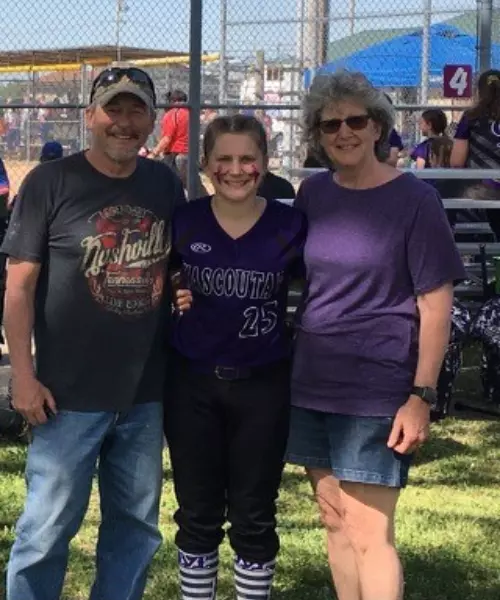May 14, 2021

Lorie Hazel is always on the go. She and her husband, Denny, love riding their RTV side-by-side all over the countryside, and Lorie frequently takes five-hour drives to visit family. But in August of 2018, she started noticing pain after sitting for long periods.
By January 2019, her lower-back pain had increased so much that she started seeing a chiropractor a few times a week. But the pain kept getting worse. “I felt like I was sitting on a ball of clay when I would sit.”
That summer, Lorie was rushed to the emergency room with appendicitis. During a CT scan in preparation for her appendectomy, the technician noticed a lump at the base of her tailbone. The doctors believed the lump was a pilonidal cyst -- an abnormal skin growth located at the tailbone that can become easily infected.
She went in to have the cyst removed a few weeks later. When she woke up from the outpatient surgery, though, she was informed it was only partially removed because it did not appear to be a cyst once they were operating on it. Six days later, she was told she actually had a chordoma tumor – a rare form of cancer found in the spine or skull.
A Team Approach
Lorie’s husband and their daughter, Becky, searched online for a chordoma specialist and found Brian Van Tine, MD, PhD, with Siteman Cancer Center. Her appointment was scheduled for October 2.
On the day of the appointment, Lorie, Denny and Becky made the drive from Mt. Vernon, Illinois to the Center for Advanced Medicine on the Washington University Medical Campus. Lorie’s other daughter, Beth, drove five hours to be at the appointment. During this visit, she first met with a radiation oncologist to discuss chemotherapy and radiation options. She then met with Dr. Van Tine, who asked Matthew Goodwin, MD, PhD – a spine surgeon with Washington University Orthopedics – to join the consultation. Lorie says, “We immediately knew that Dr. Goodwin’s personality would fit our family.”
The very next week, Lorie was scheduled for tests and scans, and a few days later, she met with Dr. Goodwin to review the plan for tumor removal. “At this visit, we met Dr. Goodwin’s resident, Dr. Inclan, and noticed both doctors were wearing crazy-looking socks. It soon became a running joke.”
During her next visit, Dr. Goodwin brought in his colleague, David Brogan, MD, MSc – a microvascular surgeon – to discuss the surgery and a flap-closing procedure.
Dr. Goodwin shares, “Having colleagues like Dr. Brogan [and Dr. Boyer] are key to being able to perform these surgeries. Chordoma is a very unique cancer in that one can perform a surgery with negative margins (no tumor in the margin), and yet small pockets of tumor cells can be up to two centimeters outside of that margin. This explains why we sometimes see recurrence rates up to 30%...even in tumors where negative margins were achieved. When possible, getting a very wide margin is key. In Lorie’s case, her prior surgery contaminated the skin and soft tissues, so there was a large area of skin, bone, tumor, and nerves that needed to be removed en bloc (in one piece). The only way this is possible is if you have a soft-tissue flap team who can put these patients back together. They are experts at moving soft tissue around to get these wounds closed; the cancer-removing surgery is not possible without them. Dr. Cara Cipriano in our orthopedic oncology service also assisted during this case. One of the great joys of treating patients here at Washington University is the incredible team approach to care.”
Dr. Brogan explains, “Each reconstructive challenge is unique, so we approach this as a team to identify the best plan for resection and reconstruction. Clear communication between team members, and a detailed discussion with the patient, is essential to obtaining the best outcome. In this case, Dr. Goodwin explained his surgical resection plan, and we developed a plan to obtain adequate soft tissue coverage based on this.”
11-Hour Surgery
On October 24, 2019, Lorie underwent an 11-hour surgery. She says, “Going through all of this, Dr. Goodwin just puts you at ease. You don’t get anxious. He is always friendly and included my family in his conversations. Before the surgery, while waiting in the surgery waiting room, I noticed the halls filling up with teams of doctors and technicians, not realizing they were all there for me.”
Dr. Goodwin explains, “Lorie is interesting for many reasons besides her tumor (she makes a mean cherry pie!). Her tumor was of interest because not only is chordoma rare, but also because there is debate about the role of surgery once the soft tissue has been contaminated. There are many physicians who feel it is impossible to get all the cancer out once it has been previously operated on. In some cases, though, the contamination is actually still resectable, as was the case with Lorie. She had contamination in the skin and muscle from her first removal attempt, but it was such that I was able to take a very wide margin all the way down to her sacrum, cut out her sacrum with the tumor, and remove all of the cancer. She is now one year out and cancer-free.”
Lorie was in the ICU for two days after her surgery, and then transferred to a regular patient room for the remainder of her stay.
Gaining Strength
Lorie’s recovery in the hospital was slow and steady. At first, she was not able to sit up past 30 degrees and needed help eating and moving in any direction. During those first post-op examinations, she had to lie on her stomach…but she always made sure to have Dr. Goodwin and Dr. Inclan show their crazy socks.
Lorie says while in the hospital, the staff made her feel so comfortable. “They were very professional with my examinations, and were always upbeat and positive.” She also remembers a conversation with Dr. Inclan about his love for Chick-Fil-A. “I’m from a small town – I had never had it,” recalls Lorie. “That afternoon, Dr. Inclan brought me some chicken nuggets and waffle fries so I could try it.” She says Dr. Goodwin’s team went out of their way to make her feel comfortable.
Lorie says, “My daughters and their families were visiting me on a day the when physical therapist came in to see if I wanted to walk for the first time after surgery. Of course I did! Before going to the hall to walk, I walked over to my four beautiful grandkids and gave them each a kiss and hug. That was the best medicine and motivation I could have! They were my strength.”
When Lorie was released to go home, her daughter set up a great support system for her, and her granddaughter, Faith, stayed with her and kept right on top of her care.
Throughout her treatment journey, Lorie says she relied on her faith and focused on her blessings. "I knew I was going to be ok because of the names of my caregivers. Matthew (Goodwin), David (Brogan) and of course, Faith.”

Denny and Lorie with their granddaughter Faith.
One in a Million
By January of 2020, Lorie felt better and was adjusting to her new normal. She even hired a personal trainer to help rebuild muscles that had atrophied during her recovery. With his help, by the middle of June, she started back to work part-time. She took things slow, continuing to walk and bend and stretch to get back her stamina.
Since then, all of her scans have been clear.
She is back to going on side-by-side rides again, and credits Dr. Goodwin for her recovery.
Lorie says, “I would recommend Dr. Goodwin to any patient with chordoma…or any patient for that matter! He has a great bedside manner. He treated my family wonderfully, and he would kid around when you needed the mood to be light. He is very personable and easy to talk to.”
Dr. Goodwin says, “Being diagnosed with cancer and then undergoing a large tumor resection is a big deal. I try to get to know my patients throughout the process because we have to be on the same page in terms of expectations. I remember when my dad was diagnosed with cancer, and how he would be having a pretty good day until someone would visit and be very gloomy and sad. I recall him telling me that he missed having normal conversations with people. Luckily, our team here at Barnes-Jewish Hospital gets that and lives that. Dr. Paul Inclan, one of our resident surgeons, was critical in her recovery. When she was feeling quite anxious over returning to the hospital and needing another surgery to address the infection, I still remember her telling me that seeing Dr. Inclan calmed her nerves and made her realize it was all going to be ok. I hope she was happy to see me, too.”
Lorie says through this process she learned how rare her cancer was: Only a handful of doctors in the U.S. specialize in treating chordoma tumors surgically, and only one person in one million people is afflicted with this disease.
Lorie says, “I’ve always told my husband I am ‘one in a million’…and now he finally believes me.”
Read more of our inspiring patient stories here.
The Washington University Orthopedics Spinal Tumor Center provides coordinated, patient-centered care for benign and malignant tumors of the spine. To schedule a consultation with one of our renowned specialists, call or visit our website: